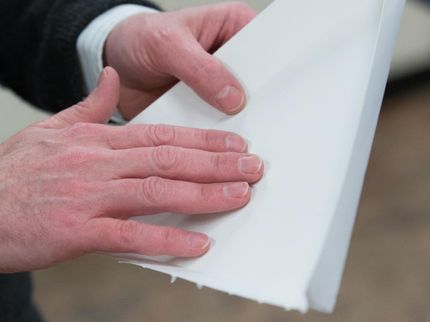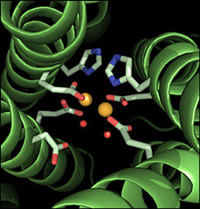Mussels - Material artists with grip
Iron atoms convey mussel fibres with a robust but stretchy covering
Researchers at the Max Planck Institute of colloids and Interfaces and collaborators at the University of California at Santa Barbara and the University of Chicago believe they have uncovered the basis how marine mussels use the byssus, a bundle of tough and extensible fibres, to fasten securely to wave-swept rocky coastlines. According to their findings, local accumulation of iron-mediated cross-links creates hard knobs within an extensible matrix containing much fewer of these molecular bridges. Such a design could be an interesting concept for developing novel abrasion-resistant, highly extensible coatings).

Fig.: (I) Mussels attach to hard surfaces in the marine intertidal zone with the byssus. (II) Byssal threads are extensible fibers with a hard and rough-textured protective cuticle (scanning electron microscopy). The knobby morphology of the cuticle originates from granular inclusions embedded in a continuous matrix. (III) The amount of dopa-iron complexes was found to be much higher in the granules than the matrix, which likely leads to their differences in mechanical performance during stretching.
Max-Planck-Gesellschaft
Byssal threads are stiff, but stretchy
We may like to eat mussels steamed in white wine, but we also like to find mussels at the beach. Mostly they are burrowed into the ground or tethered to rocks. But if you look closer you will find a mollusc which has adapted to life and nutrition in a special and fascinating way. Mussels thrive in rocky seashore habitats, in spite of the enormous physical demands present there. This is in no small part due to the evolution of the byssus, which mussels employ to tether themselves to accessible surfaces.
The individual byssal threads that compose the byssus are stiff, but stretchy and are fashioned by the mussel in a process resembling injection molding. Byssal threads are depended upon for dissipating the energy of crashing waves and also for resisting abrasive damage from water-borne debris. To this end, threads are sheathed with a thin and knobby outer cuticle; a biological polymer, which exhibits epoxy-like hardness, while straining up to 100% without cracking.
Incredibly hardness and extensibility
Matthew Harrington, a researcher who worked on the project and Humboldt fellow at the Max Planck Institute for Colloids and Interfaces explains the motivation for studying the byssus cuticle: "Protective coatings are important for prolonging the lifetime of materials and devices. However, considering that hardness and extensibility are seldom coupled in engineered polymers or composites, understanding how one protects a flexible substrate becomes quite important." Byssal cuticles have a knobby appearance due to inclusions of submicron-sized granular structures in an apparently continuous matrix. Submicron-sized tears that form in the matrix during stretching of the cuticle are believed to hinder the formation of larger cracks that could lead to material failure.
Central to understanding the peculiar mechanical behaviour of the cuticle are the high concentration of iron ions in the cuticle and the presence of an uncommon modification of the amino acid tyrosine known commonly as dopa. Dopa is found at high concentrations in the main cuticle component, mussel foot protein-1 (mfp-1). Dopa is distinguished from typical amino acids due to its impressive affinity for complexing with transition metal ions, particularly iron. As Admir Masic, a scientist at the Max Planck Institute for Colloids and Interfaces who worked on the project, explains, "when 2-3 dopa residues complex with a single iron ion, they create an incredibly stable complex that can be utilized to cross-link structural proteins." These metal-protein complexes have a high breaking force (nearly half that of covalent bonds), but unlike covalent bonds they are reversibly breakable, making them ideal for creating sacrificial cross-links.
Cuticle is stabilized by dopa-iron complexes
Using a technique known as in situ Raman spectroscopy to probe the chemical composition of the cuticle, the researchers provided the first direct evidence that the cuticle is a protein-based polymeric scaffold stabilized by dopa-iron complexes. Moreover, it was discovered that the distribution of dopa-iron complexes is clustered, with areas of high density coinciding with the granular inclusions and low density with the inter-granular matrix. These observations, coupled with previous mechanical observations suggest that the densely cross-linked granules function as hard inclusions and the less cross-linked matrix functions in a sacrificial manner, allowing bonds to break prior to catastrophic failure.
"Nature has evolved an elegant solution to a problem that engineers are still struggling with; namely, how to combine the properties of abrasion resistance and high extensibility in the same material", says Peter Fratzl, director of the biomaterials department at the Max Planck Institute for Colloids and Interfaces. Apparently, the cuticle achieves this through a careful tailoring of protein-metal chemistry and the submicron organization of cross-link density. "Conceivably, this same strategy could be applied in engineered polymers and composites."
Original publication: Matthew J. Harrington, Admir Masic, Niels Holten-Andersen, J. Herbert Waite, and Peter Fratzl; "Iron-clad fibers: a metal-based biological strategy for hard flexible coatings"; Science 2010.
Other news from the department science
Most read news
More news from our other portals
See the theme worlds for related content
Topic World Spectroscopy
Investigation with spectroscopy gives us unique insights into the composition and structure of materials. From UV-Vis spectroscopy to infrared and Raman spectroscopy to fluorescence and atomic absorption spectroscopy, spectroscopy offers us a wide range of analytical techniques to precisely characterize substances. Immerse yourself in the fascinating world of spectroscopy!

Topic World Spectroscopy
Investigation with spectroscopy gives us unique insights into the composition and structure of materials. From UV-Vis spectroscopy to infrared and Raman spectroscopy to fluorescence and atomic absorption spectroscopy, spectroscopy offers us a wide range of analytical techniques to precisely characterize substances. Immerse yourself in the fascinating world of spectroscopy!





















































